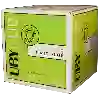
Domaine de JoyElixir de Joy Moelleux
In the mouth this sweet wine is a powerful with a good balance between acidity and sweetness.
This wine generally goes well with fruity desserts, blue cheese or mature and hard cheese.
The Elixir de Joy Moelleux of the Domaine de Joy is in the top 80 of wines of Côtes de Gascogne.
Taste structure of the Elixir de Joy Moelleux from the Domaine de Joy
Light | Bold | |
Dry | Sweet | |
Soft | Acidic |
In the mouth the Elixir de Joy Moelleux of Domaine de Joy in the region of Comté Tolosan is a powerful with a good balance between acidity and sweetness.
Wine flavors and olphactive analysis
Food and wine pairings with Elixir de Joy Moelleux
Pairings that work perfectly with Elixir de Joy Moelleux
Original food and wine pairings with Elixir de Joy Moelleux
The Elixir de Joy Moelleux of Domaine de Joy matches generally quite well with dishes of mature and hard cheese, fruity desserts or blue cheese such as recipes of chard with meat and mustard, apple pie or cheese lasagne.
Details and technical informations about Domaine de Joy's Elixir de Joy Moelleux.
Discover the grape variety: Gros Manseng
Gros Manseng blanc is a grape variety that originated in France (Netherlands). It produces a variety of grape specially used for wine making. It is rare to find this grape to eat on our tables. This variety of grape is characterized by medium-sized bunches and small grapes. Gros Manseng blanc can be found in several vineyards: South-West, Languedoc & Roussillon, Cognac, Bordeaux, Armagnac, Provence & Corsica, Rhone valley, Loire valley, Savoie & Bugey, Beaujolais.
Last vintages of this wine
The best vintages of Elixir de Joy Moelleux from Domaine de Joy are 2017, 2016, 0
Informations about the Domaine de Joy
The Domaine de Joy is one of of the world's greatest estates. It offers 29 wines for sale in the of Côtes de Gascogne to come and discover on site or to buy online.
The wine region of Côtes de Gascogne
The wine region of Côtes de Gascogne is located in the region of Comté Tolosan of Vin de Pays of France. Wineries and vineyards like the Domaine Sichel or the Domaine Haut-Marin produce mainly wines white, red and sweet. The most planted grape varieties in the region of Côtes de Gascogne are Colombard, Gros Manseng and Merlot, they are then used in wines in blends or as a single variety. On the nose of Côtes de Gascogne often reveals types of flavors of red fruit, tangerine or jam and sometimes also flavors of watermelon, pomegranate or lemon grass.
The wine region of Comté Tolosan
Comte Tolosan is a PGI title that covers wines produced in a large area of Southwestern France. The PGI basin encompasses 12 administrative dePartments and is home to a wide range of appellations d'origine contrôlée (AOC) such as Jurançon, Cahors and Armagnac. The IGP label provides a geographical classification for wines that are not classified for AOC level appellations due to Grape variety or winemaking style. The region is part of the Aquitaine basin - the plains that lie between the Pyrenees, the Massif Central and the Atlantic Ocean to the west.
The word of the wine: Cordon de Royat (size in)
Short trellised pruning with one or two horizontal arms stretched over a wire. Very suitable for mechanization, it offers a very good exposure of the bunches as well as an excellent aeration.














